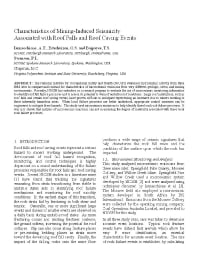Mining Publication: Characteristics of Mining-Induced Seismicity Associated with Roof Falls and Roof Caving Events
Original creation date: June 2005
Authors: AT Iannacchione, GS Esterhuizen, TS Bajpayee, PL Swanson, MC Chapman
NIOSHTIC2 Number: 20028125
Proceedings of the 40th U.S. Rock Mechanics Symposium, Anchorage, AK, June 25-29, 2005. Alexandria, VA: American Rock Mechanics Association, 2005 Jun; :1-10
The National Institute for Occupational Safety and Health (NIOSH) evaluated microseismic activity from three field sites to compare and contrast the characteristics of microseismic emissions from very different geologic, stress, and mining environments. Recently, NIOSH has embarked on a research program to evaluate the use of microseismic monitoring information to identify roof fall failure processes and to assess its potential to warn of unstable roof conditions. Large roof instabilities, such as roof falls and certain roof caving events, have proven difficult to anticipate, representing an increased risk to miners who work in these inherently hazardous areas. When local failure processes are better understood, appropriate control measures can be engineered to mitigate these hazards. This study used microseismic emissions to help identify three local rock failure processes. It was also shown that analysis of microseismic emissions can aid in assessing the degree of instability associated with these local rock failure processes.

NIOSHTIC2 Number: 20028125
Proceedings of the 40th U.S. Rock Mechanics Symposium, Anchorage, AK, June 25-29, 2005. Alexandria, VA: American Rock Mechanics Association, 2005 Jun; :1-10
- Detecting Strata Fracturing and Roof Failures from a Borehole Based Microseismic System
- An Evaluation of Microseismic Activity Associated with Major Roof Falls in a Limestone Mine: a Case Study
- Forecasting Roof Falls with Monitoring Technologies - A Look at the Moonee Colliery Experience
- Mapping Hazards with Microseismic Technology to Anticipate Roof Falls - A Case Study
- Methods for Determining Roof Fall Risk in Underground Mines
- Practical Risk Assessment Guidelines for Identifying, Assessing, and Mitigating Stored Energy Hazards in Underground Coal Mines During and After a Mine Emergency
- The Relationship of Roof Movement and Strata-Induced Microseismic Emissions to Roof Falls
- SPONCOM - A Computer Program for the Prediction of the Spontaneous Combustion Potential of an Underground Coal Mine
- Stability Mapping to Examine Ground Failure Risk: A Field Study at a Limestone Mine
- Technology News 545 - NIOSH Updates Spontaneous Combustion Assessment Software